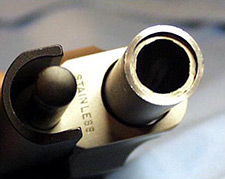- 01: Introduction
- 02: History
- 03: Propellants, Firearms, and Ammunition Development
- 04: Modern Firearms Manufacture
- 05: Small Arms Ammunition
- 06: Evidence Handling Procedures
- 07: Equipment and Instrumentation
- 08: Examination of Firearms
- 09: Cartridge and Shotshell Examination
- 10: Characterization and Evaluation of Fired Projectiles
- 11: Bullet Comparison and Identification
- 12: Gunshot Residue and Distance Determination
- 13: Toolmark Identification
- 14: Communicating Results
- Resources


Contouring/Profiling
Home > Modern Firearms Manufacture > Rifled Barrels > Contouring/Profiling

Contoured muzzle
Most rifled barrels come off the machinery with a straight and oversized external profile. For some barrels, solid protrusions must be left after completion to allow for sight mounting or bearing lugs. Finish machining produces these features, using the precisely aligned bore as the index point.
Most sporting rifles have a tapered barrel for aesthetics and weight reduction. These are commonly profiled by lathe-turning after rifling. For an accurate barrel, the metal must be exactly the same thickness at every point along its length. Failing to observe this tenet of barrel making will result in asymmetrical stresses and vibration during firing. Again, a precisely placed borehole (index point) is the basis for barrel symmetry.
The finishing operation that can affect the examiner’s ability to compare a bullet to a barrel is crowning the muzzle (bullet exit point). If a barrel is left with a perfectly flat muzzle, the edges of the rifling are exposed to the potential for mechanical damage. Accidentally striking the end of the barrel against a rock or other hard surface can create burrs. These defects can negatively affect the exit of the bullet from the barrel by degrading accuracy, thus shifting the point of impact. To avoid such damage, barrel makers recess the rifling through crowning.

Recessed muzzle
In its simplest form, crowning can be accomplished with a countersink drill. However, a coarse countersink can also leave burrs. Crowning is frequently accomplished with a shaped mild steel lap covered in fine grinding paste. Target arms are often fitted with a machined, flat-bottom recess that leaves the rifling edges sharp but slightly below the end of the barrel for protection.
Any crowning operation can contribute to individual marks that will characterize a bullet. If this occurs, it is a function of the method of rifling, the barrel material, and the crowning method.




